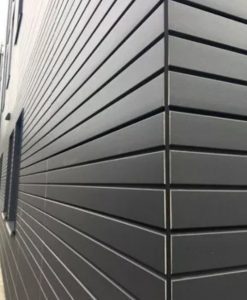
Adam’s email:
Hello there. We are currently in discussions with our architect and local council regarding building a straw bale home in New Zealand. I have your DVD. The site for our house is too exposed for a plastered straw bale home so we want to construct a covered straw bale home- using corrugated iron on the outside over the straw bales- do we have to plaster the outside of the strawbale home even though it’s covered and won’t be exposed to the elements?
My Response:
Adam,
There are two things you need to consider in order to wrap the exterior of the house in the manner you describe. The first is that you will have to place at least a slip coat of plaster on the bales before you add the metal. This is not to protect against the elements but to reduce the fire risk. Without any plaster, the bales remain “hairy” and could channel flame spread. The other consideration is the breathibility of the assembly once you place the metal over the bales.
It seems there might a tendency for the metal to condense and drop water into the bales. Also, any moisture moving from the inside to the outside of the structure would be trapped behind the metal. You might consider using a product like a mortar net (www.mortarnet.com) to separate the bales from the metal and to give a potentially drainable skin between the bales and the metal. Good luck.
More to Say:
What I didn’t ask before is exactly why you think the site is too exposed for plastered bales. That is a crucial piece of understanding that I believe needs to be addressed. The use of the corrugated metal will ultimately work; however, it presents a lot of extra work in order to make it functional. Plaster can be very suitable to many environments as long as it is applied properly and protected with smart design details. So, I guess I would have suggested that Adam use plaster unless he is absolutely sure he cannot do so successfully.



8 Responses
Hi, I have a house whose pantry window gets a lot of direct sun. I have stacked some hay bails up against it and the relief is great. Can you individually wrap straw bails in a fire retardant canvas and then stack them up against an already built wall?
Hi Kate. Thanks for your question. There are several things you’d have to address in doing a wrap, fire resistance is one of them. You’d also have to consider foundation requirements, roofing/weather resistance, and bug/pest infiltration. If you plan to use this as a temporary fix, then you’d likely be fine with simply addressing the fire issue, but if you want to create something more permanent, you would be better off addressing all of the issues that could present themselves. Cheers.
We are also considering using metal on exterior of our straw bale home. If we applied a moisture barrier as well as leaving an airspace, do you think that would work?
As long as you are sure to add at lest a slip coat of plaster to the bales to protect them from flame spread and include a vented space between the bales and metal, you will be fine. You can add a moisture barrier over the slip plastered bales too if you like. Cheers.
This is a question that we are debating now int he design phase. I plan on attending your design workshop in Oregon this fall(2019). We are building off grid, in a heavy snow region in SW Montana at 5500′ elevation. Our question/concern is do we clad the exterior with steel siding to combat snow from piling up against the exterior walls? We are concerned that a limestone plaster may not perform as well as steel siding in protecting against snow/water damage. Your thoughts? I have learned to rely and accept your knowledge and expertise on these issue and greatly appreciate your site and your willingness to share. Many Thanks.
Hi Barry. Hopefully I answered this in person at the workshop, I don’t remember. Snow piled up against a plastered straw bale wall is not a problem because there is not heat loss through the wall like there is in conventional homes. The snow won’t melt from the inside as a result. The snow will melt from the outside in, towards the house, so the snow in contact with the wall will stay cold and dry until the final melting occurs.
You can indeed install metal siding if that is something you prefer. Be sure to use a rainscreen assembly to provide adequate ventilation between the siding and the bales. The bales will need a scratch coat of plaster on them to prevent flame spread before the final siding is added.
Will this be reliable to construct in a tropical country? I’m concerned that percentages of it rotting is higher as well, any recommendations?
Hi Jo. It depends on the level of humidity you would be dealing with. I would definitely recommend using some high-humidity details if building in a tropical climate. Things like installing mechanical air circulation, like an HRV, to help remove excess moisture from the room; providing a ventilation gap between the bales and any siding other than plaster (metal, wood, etc.) so that there is no risk of moisture being trapped between the two materials; designing for best use of solar gain and wind exposure to promote drying of the structure, etc. You may want to install moisture sensors in the walls to keep an eye on things so that if levels get high, you can address any issues causing the increase quickly.